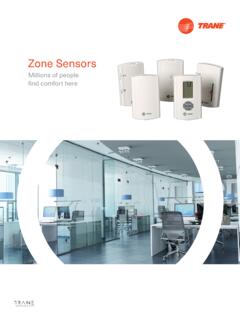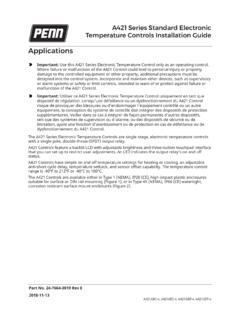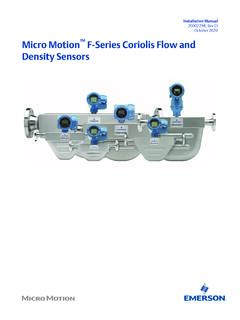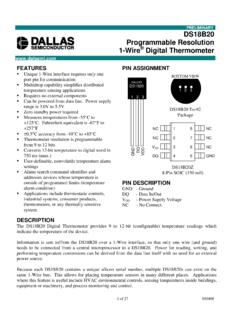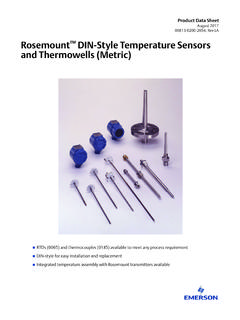Transcription of Fiber Optic Sensors: Fundamentals and Applications
1 Fiber Optic Sensors: Fundamentals and Applications September, 2015. David Krohn, Light Wave Venture LLC. 203-248-1475. Presentation Focus The major focus of this presentation will be on distributive Fiber Optic sensors which has seen the greatest usage However, key Applications for point sensors will be discussed The market dynamics will be covered briefly Fiber Optic sensor Commercialization Evolution Sensors Telecom R&D- Military and Industrial R&D- Telecommunications 1975. Laboratory Devices Multimode Systems; Mb/s transmission 1980. 1st Industrial Applications and Military Advent of Single Mode Systems; Major 1985 Systems Infrastructure Build 1st Commercial Gyroscope; Medical EDFA; Undersea Systems; Gb/s 1990 Applications transmission 1st Oil & Gas Field Trials and Smart Optical Component Advancements and 1995 Structures.
2 First FBG interrogators. DWDM. 1st Commercial Oil & Gas Systems Optical Networks; Market Peak at 2000 $18B; Tb/s transmission Broad commercialization of sensors & Trials for 100Gb systems. R&D on 2010 instrumentation multi-core fibers Key enabling technology for North 2014 American energy independence Advantages of Fiber Optic Sensors Nonelectrical Explosion proof Often do not require contact Remotable Small size and light weight Allow access into normally inaccessible areas Potentially easy to install (EMI). Immune to radio frequency interference (RFI) and electromagnetic interference (EMI). Solid state reliability High accuracy Can be interfaced with data communication systems Secure data transmission Resistant to ionizing radiation Can facilitate distributed sensing . Can function in harsh environments Light Modulation Effects Used by Fiber Sensors to Detect a Physical Parameter Classification of Optical Fiber Sensors by Transducing Approach Fiber itself is the transducer DIRECT.
3 (intrinsic). Transducer INDIRECT acts on the Fiber (extrinsic). Fiber carries HYBRID light in and out of the device Classification of Optical Fiber Sensors According to their Topology Fiber Optic Distributed Sensors Fiber Optic Distributed Sensors Interferometric Bragg Grating Raman (DTS) Brillouin (DTSS) Rayleigh (DAS). Multi Point Continuous Multi Point Continuous Continuous Continuous Phase Intensity Frequency Temp Temp Strain Strain Temp Temp Vibration Vibration Vibration Strain Acoustic Pulse Phase Modulated Sensors Interferometers Mach Zehnder interferometer configuration Michelson Interferometer configuration Interferometers Fabry Perot interferometer configuration Sagnac interferometer configuration Phase Detection Change in length due to mechanical or thermal strain will cause a phase change (Mach-Zehnder interferometer).
4 2 . + = [n1 L + n1 L ]. 0. Phase change of a light wave through an optical Fiber of original length L that has been stretched by a length ? L. Intensity versus relative phase shifts due to constructive and destructive interference Provides extremely high resolution Noise issues such as phase noise and multimode noise are addressed in the detection schemes Fabry-Perot Interferometric sensor Concepts Bragg Air Gap Reflections Grating L. L. Fiber L L. Distributed Interferometric sensor Configurations Interferometric Sensing Performance Long term accuracy - <1%. Resolution - < microstrain Position Resolution 1 meter in 10 Km length Can monitor dynamic strain over a broad range of frequencies vibration signature There is a trade-off between distance range and frequency bandwidth (due to time-of-flight limitations). How Does a Fiber Optic Hydrophone Work?
5 Hollow Mandrel . sensitive to Pressure Variations Solid Mandrel . Insensitive to Pressure Variations Source: Northrop Grumman FOS Milestones: Hydrophone Development Installed on 62 USS Virginia class nuclear submarines FO Planar hydrophone Arrays (three flat panels mounted low along either side of the hull), as well as two high frequency active sonars mounted in the sail and keel (under the bow). The result of 15+ years of R&D and $140M of investment! Wavelength Modulated Sensors Fiber Bragg Gratings Reflected Signal Transmitted Signal Fiber Bragg Grating sensor . Bragg Grating sensor The change in wavelength, associated with both strain and temperature effects, is given by: dn . n . 2.. B = 1 P12 v ( P11 + P12 ) ] + + dT T , 2 n .. where: e = the applied strain, P11, P12 = the stress Optic coefficient, a = the coefficient of thermal expansion, ?
6 = Poisson's ratio, n = the refractive index of the core, and ? T = the temperature change. For constant temperature n This relationship corresponds to 1 nm of wavelength change for 100 microstrain at a wavelength of 1300 nm. For the case of zero applied strain 1 B. = 10 6 / C. B T. At 1300 nm, a change in temperature of 1 C results in a Bragg wavelength shift (??B) of nm. Bragg Grating sensor Response Bragg Grating Sensors Performance Resolution - < microstrain Input Signal Long term accuracy - <1%. Bragg Grating Up to 20 sensing points in C band Can monitor low frequency dynamic strain Temperature resolution of 1oC. Optical Fiber Strain / temperature discrimination is Reflected Signal Strain Induced Spectral required Shift Bragg Grating Distributed Sensing System Configurations WDM. TDM/WDM. High Capacity WDM Distributed Sensing System Using Bragg Gratings Source: Micron Optics Bridge Failure in Minneapolis MN.
7 Conceptual Use of Static and Dynamic Strain Monitoring in a Bridge Application Strain change with Time Associated with Bridge Traffic Source: Micron Optics Scattering Based Sensors Distributed Sensing Applications Distributed Sensing System Based on Scattering Emission from Raman, Brillouin and Rayleigh Scattering Raman Scattering Process in Optical Fiber Source: Sumitomo & LIOS. Raman Scattering Distributed Temperature Sensing (DTS). Temperature and Strain Sensitivities for Various Scattering Effects in Optical Fiber Raman Scattering Performance Only measures temperature and is independent of strain. The temperature resolution is The measurement range is up to 15 km with a 1 meter spatial resolution (up to 25km with a meter resolution) of the location of the temperature perturbation Brillouin Scattering Performance The measurement range of up to 30 km.
8 The sensing point associated with a physical perturbation can be resolved to 1 meter on a 10 km length, but accuracy is reduced as distance increases. The strain resolution is 20 microstrain. However, more advanced detection schemes can have a strain resolution of microstrain. The temperature resolution is While Brillouin scattering is an excellent strain sensor technology, the response time is about 1 second; and therefore, is not suitable for vibration measurements. Mach-Zehnder Interferomter Based on Rayleigh Scattering Discrete Performance Fourier Accuracy - 2 strain Reference Transform Spatial resolution 1 cm Scanning laser Detector Max. length - 50 meters Output Reflection 1 ReflectedIntensity Reflection1. Reflection 2. Reflection 2. Mach-Zehnder Interferometer Distance, Frequency Distributed Acoustic Sensing (DAS).
9 Based on Rayleigh backscattered light in an optical Fiber (single mode or multi mode). It senses all points along the Fiber and monitors acoustic perturbations to the Fiber Specifications Frequency range - 1mHz to 100kHz Spatial resolution - 1 m Length 50 km Strong Applications Oil and gas seismic Pipeline monitoring Oil & Gas Applications Fiber Optic Sensors in Oil & Gas Source: Weatherford DTS - SAGD. Steam Assisted Gravity Drainage (SAGD) is an enhanced oil recovery technology for producing heavy crude oil utilizing steam injection 80% of oil sands require enhanced recovery techniques such as SAGD. Optimizing steam management optimizes reservoir production, reduces costs and limits emission Monitoring the temperature profile of the steam chamber growth is key to process and efficiency improvements Distributed Fiber Optic temperature sensing systems have Source: Petrospec provided the monitoring capability Advent of Permanent Ocean Bottom Cable (OBC) Seismic Systems Seismic reservoir management tool to optimize production Major franchises formed Optical System Deployment Courtesy Petroleum Geo-Services Interpretation Oil Company Sponsors Fiber Optics: reach, channel count.
10 Reliability Early growth stage Between $20-50M cost per field to customer Large incremental growth potential Source - Qorex Pipeline Distributed Fiber Optic Monitoring System Fiber Optic interferometric array monitors Interferometric about 25 Kmand DAS. systems can monitor 25. Multiple arrays km or longer DTScover and hundreds DTSS systemsof km been used to have monitor leaks which Data transferred cause wireless through a local temperature node drop In evaluation trials Source: Sabeus Pipeline Leak Detection (Distributed Brillouin Scattering). Source: Omnisens DAS Acoustic Signatures Source: OptaSense Magnetic and Electric Field Sensors Fiber Optic Magnetic Field sensor Architectures Faraday Rotating Optic Attached Polarizing Optics Low Verdet constant in Fiber requires long path length compared with bulk Faraday rotators ensor with Piez Coatings Magnetostrictive coating can be used for magnetic field sensors High sensitivity potential Biophotonic Sensors Biosensor Concept Intrinsic Biophotonic Sensors Mechanisms Concepts Absorption Scattering Evanescent Wave Interaction Raman Scattering Photonic Bandgap Confinement Index of Refraction Fluorescence Arrays Fluorescence Flow Cytrometry Biophotonic Interaction Modulated Mach-Zehnder Interferometer Evanescent Wave Fluoroimmunoassay Concept Fiber Optic Enabled Arrays using Fluorescence for High Speed Screening Fluorescent Array Microsphere Vapor Sensors

